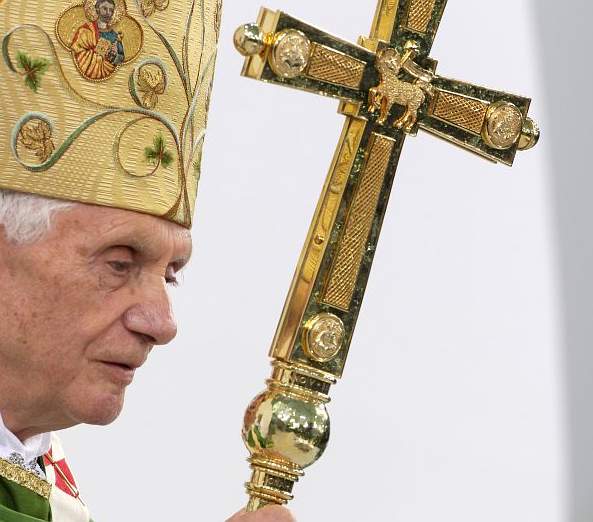Mikkelsmesse i dag
Dagens feiring er i den gamle kalender forbeholdt bare erkeengelen Mikael, mens feiringen i den nye kalenderen er utvidet til alle de tre erkeenglene Mikael, Gabriel og Rafel. På katolsk.no forklares dette ganske greit (se slutten av artikkelen):
29. september har alltid vært erkeengelen Mikaels minnedag. At den feires på denne dato skyldes at man årlig mintes innvielsen av kirken S. Michele på Via Salaria ved Roma under den hellige pave Leo den Store på 400-tallet. Dokumentasjon finnes i Hieronymus’ martyrologium og kalenderen i Verona. I den etiopiske ritus er det en minnedag den tolvte dagen hver måned. I den bysantinske kirken feires Mikael den 8. november. I den latinske kirken ble festen for disse tre erkeenglene godkjent av Laterankonsilet i 745. De to andre erkeenglene er lenge blitt æret i østens liturgi. Før dette århundret hadde de andre erkeenglene bare festdager i lokale vestlige liturgikalendere. På 1400-tallet ble Gabriel feiret for eksempel 18. mars og 3. desember, mens Rafaels fest ble lokalt feiret 8. juli og 6. eller 13. oktober. Englekulten gikk gjennom en betydelig utvikling på 1500-tallet, og pave Pius IV konsekrerte Michelangelos kirke i Diokletians termer til Maria og de Sju erkeenglene.
Pave Benedikt XV kunngjorde i 1921 at den katolske kristenhet skal feire erkeengelen Gabriel den 24. mars, men i øst feires han den 26. mars, dagen etter Herrens bebudelse. Det er også ifølge norsk tradisjon. Festen for erkeengelen Rafael ble feiret på forskjellige dager siden middelalderen, før pave Benedikt XV i 1921 la festen til 24. oktober og gjorde den (og festen for Den hellige Familie) obligatorisk for hele Kirken. Ved kalenderrevisjonen i 1969 ble festene for erkeenglene slått sammen. Minnedagen er også avmerket på den norske primstaven.
Erkeengelen Mikael er blitt mindre viktig etter liturgireformen, fordi han nå ikke lenger har sin egen dag, og enda mer av to andre grunner.
1) Før 1969 ble han alltid nevnt i messens syndsbeskjennelse:
Jeg bekjenner for Gud den allmektige, den hl. Maria, alltid jomfru, den hl. erkeengel Mikael, den hl. Johannes døperen, de hl. apostler Peter og Paulus, alle hellige og for dere brødre, at jeg har syndet meget i tanker, ord og gjerninger: ved min skyld, ved min skyld, ved min store skyld. Derfor ber jeg den hl. Maria, alltid jomfru, den hl. erkeengel Mikael, den hl. Johannes døperen, de hl. apostler Peter og Paulus, alle hellige og dere brødre, be for meg til Herren vår Gud.
2) I stille messer før 1969 ba man alltid noen bønner etter messen (knelende foran alteret), bl.a. denne til erkeengelen Mikael:
Hellige erkeengel Mikael, forsvar oss i striden, verg oss mot djevelens ondskap og list. Ydmykt trygler vi om at Gud må holde den onde i age. Og deg, som er høvding for de himmelske hærskarer, ber vi om at du, med den kraft som Gud har gitt deg, vil styrte i avgrunnen Satan og de andre ondskapens ånder som til sjelenes ulykke ferdes omkring i verden. Amen.

 Peter Seewald har skrevet flere bøker om kardinal Ratzinger/pave Benedikt og uttaler seg interessant om pavens siste besøk i Tyskland. Han sier bl.a.:
Peter Seewald har skrevet flere bøker om kardinal Ratzinger/pave Benedikt og uttaler seg interessant om pavens siste besøk i Tyskland. Han sier bl.a.: Vårt Land hadde i sin papirutgave i går en overraskende artikkel med overskrift «Paven hyller Luther», som i alle fall er en hel del bedre enn «Strides om paven tilga Luther», som
Vårt Land hadde i sin papirutgave i går en overraskende artikkel med overskrift «Paven hyller Luther», som i alle fall er en hel del bedre enn «Strides om paven tilga Luther», som 
